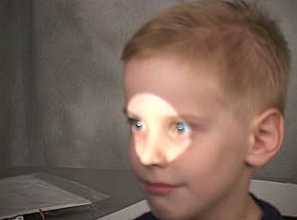A children’s cancer charity is calling for all squints in babies and young children to be checked with a red reflex test to rule out eye cancer.
Figures released from the Childhood Eye Cancer Trust (CHECT) show that in 2013, over a quarter (26%) of babies and young children diagnosed with retinoblastoma (Rb) presented with a squint as a symptom.1 It is the second most common symptom after leukocoria (white pupillary reflex).
Joy Felgate, Chief Executive of CHECT said: “In our experience, some babies and young children are facing serious delays in receiving life-saving treatment as a result of parents either being told incorrectly that their baby’s squint is completely normal, or being given a non-urgent squint referral.”
Katy Bishop’s son Owen was incorrectly referred to a squint clinic at five months of age. His bilateral retinoblastoma was not diagnosed until he was ten months old. “Owen was too young to tell me his vision was failing, and his diagnosis was delayed five months because his squint was not properly checked. By the time he was diagnosed, he had a detached retina and was borderline for enucleation. Since then, he has had chemotherapy, cryotherapy and blood transfusions. We will never know the impact that five months’ delay has had on Owen’s future.”
As squints are common in babies up to the age of three months, the only way to determine whether this is a sign of a much more serious condition is to carry out a simple red reflex test, which is a non-invasive procedure, simply involving looking in the eye with a hand-held ophthalmoscope.
Mrs Felgate continued: “Non-urgent squint referrals can take months to come through, which can be a devastating delay for a child with undiagnosed eye cancer. Retinoblastoma is a very aggressive form of cancer and any delays in diagnosis can have a serious impact on treatment options. Currently more than 70% of children with unilateral Rb lose an eye to the disease.
“We are asking GPs to check every squint they see with the red reflex test.”
To promote this message CHECT has developed e-cards and an email campaign that GPs can share and forward on to colleagues. Copies of these are available from info@chect.org.uk.
Retinoblastoma is a fast-growing cancer of the eye affecting mainly 0 to 5-year-old children. Early detection of this aggressive condition is crucial to offer the child the best chance of saving their vision, their eyes and their life.
CHECT urges GPs to pay particular attention to children with
- A recently onset squint
- A white reflex (leukocoria) or an abnormal reflex in flash photographs
- A change in colour to the iris
- A deterioration in vision
Occasionally a retinoblastoma may present as a red, sore or swollen eye without infection. It is important to remember, however, that a child with Rb may appear systemically well.
Following a successful campaign by CHECT, most of these symptoms are now also listed in the latest versions of the Public Child Health Record (red book).
If any of the above symptoms are detected, a simple red reflex test can rule out retinoblastoma.
If you are unable to confidently rule out retinoblastoma with a red reflex test NICE guidelines state an urgent referral must be made to the local ophthalmology department stating ‘suspected retinoblastoma’. We recommend you call to alert them to the case and to find out how quickly urgent referrals are seen (in some cases it can be longer than two weeks).
http://www.medicalnewstoday.com/releases/276723.php

